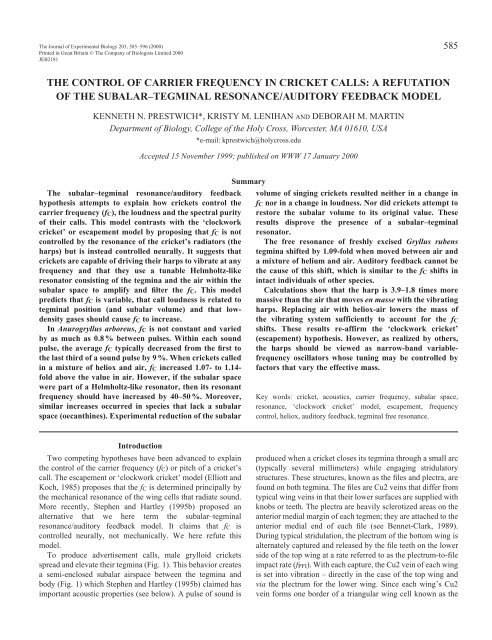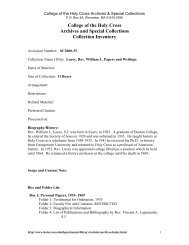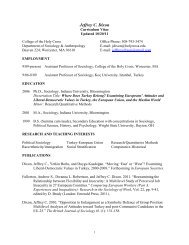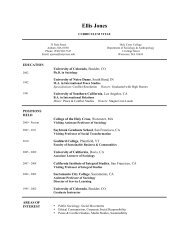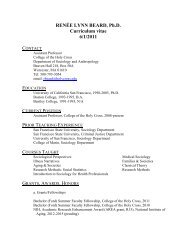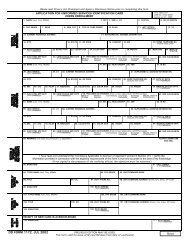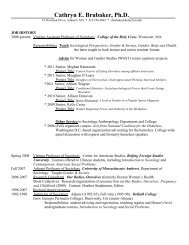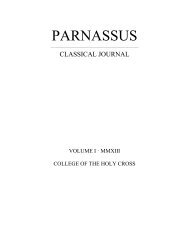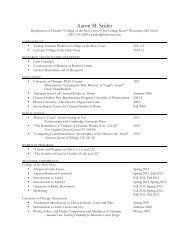Control of frequency in cricket song - The Journal of Experimental ...
Control of frequency in cricket song - The Journal of Experimental ...
Control of frequency in cricket song - The Journal of Experimental ...
You also want an ePaper? Increase the reach of your titles
YUMPU automatically turns print PDFs into web optimized ePapers that Google loves.
<strong>The</strong> <strong>Journal</strong> <strong>of</strong> <strong>Experimental</strong> Biology 203, 585–596 (2000)<br />
Pr<strong>in</strong>ted <strong>in</strong> Great Brita<strong>in</strong> © <strong>The</strong> Company <strong>of</strong> Biologists Limited 2000<br />
JEB2181<br />
THE CONTROL OF CARRIER FREQUENCY IN CRICKET CALLS: A REFUTATION<br />
OF THE SUBALAR–TEGMINAL RESONANCE/AUDITORY FEEDBACK MODEL<br />
KENNETH N. PRESTWICH*, KRISTY M. LENIHAN AND DEBORAH M. MARTIN<br />
Department <strong>of</strong> Biology, College <strong>of</strong> the Holy Cross, Worcester, MA 01610, USA<br />
*e-mail: kprestwich@holycross.edu<br />
Accepted 15 November 1999; published on WWW 17 January 2000<br />
<strong>The</strong> subalar–tegm<strong>in</strong>al resonance/auditory feedback<br />
hypothesis attempts to expla<strong>in</strong> how <strong>cricket</strong>s control the<br />
carrier <strong>frequency</strong> (fC), the loudness and the spectral purity<br />
<strong>of</strong> their calls. This model contrasts with the ‘clockwork<br />
<strong>cricket</strong>’ or escapement model by propos<strong>in</strong>g that fC is not<br />
controlled by the resonance <strong>of</strong> the <strong>cricket</strong>’s radiators (the<br />
harps) but is <strong>in</strong>stead controlled neurally. It suggests that<br />
<strong>cricket</strong>s are capable <strong>of</strong> driv<strong>in</strong>g their harps to vibrate at any<br />
<strong>frequency</strong> and that they use a tunable Helmholtz-like<br />
resonator consist<strong>in</strong>g <strong>of</strong> the tegm<strong>in</strong>a and the air with<strong>in</strong> the<br />
subalar space to amplify and filter the fC. This model<br />
predicts that fC is variable, that call loudness is related to<br />
tegm<strong>in</strong>al position (and subalar volume) and that lowdensity<br />
gases should cause fC to <strong>in</strong>crease.<br />
In Anurogryllus arboreus, fC is not constant and varied<br />
by as much as 0.8 % between pulses. With<strong>in</strong> each sound<br />
pulse, the average fC typically decreased from the first to<br />
the last third <strong>of</strong> a sound pulse by 9 %. When <strong>cricket</strong>s called<br />
<strong>in</strong> a mixture <strong>of</strong> heliox and air, fC <strong>in</strong>creased 1.07- to 1.14fold<br />
above the value <strong>in</strong> air. However, if the subalar space<br />
were part <strong>of</strong> a Helmholtz-like resonator, then its resonant<br />
<strong>frequency</strong> should have <strong>in</strong>creased by 40–50 %. Moreover,<br />
similar <strong>in</strong>creases occurred <strong>in</strong> species that lack a subalar<br />
space (oecanth<strong>in</strong>es). <strong>Experimental</strong> reduction <strong>of</strong> the subalar<br />
Introduction<br />
Two compet<strong>in</strong>g hypotheses have been advanced to expla<strong>in</strong><br />
the control <strong>of</strong> the carrier <strong>frequency</strong> (fC) or pitch <strong>of</strong> a <strong>cricket</strong>’s<br />
call. <strong>The</strong> escapement or ‘clockwork <strong>cricket</strong>’ model (Elliott and<br />
Koch, 1985) proposes that the fC is determ<strong>in</strong>ed pr<strong>in</strong>cipally by<br />
the mechanical resonance <strong>of</strong> the w<strong>in</strong>g cells that radiate sound.<br />
More recently, Stephen and Hartley (1995b) proposed an<br />
alternative that we here term the subalar–tegm<strong>in</strong>al<br />
resonance/auditory feedback model. It claims that fC is<br />
controlled neurally, not mechanically. We here refute this<br />
model.<br />
To produce advertisement calls, male grylloid <strong>cricket</strong>s<br />
spread and elevate their tegm<strong>in</strong>a (Fig. 1). This behavior creates<br />
a semi-enclosed subalar airspace between the tegm<strong>in</strong>a and<br />
body (Fig. 1) which Stephen and Hartley (1995b) claimed has<br />
important acoustic properties (see below). A pulse <strong>of</strong> sound is<br />
Summary<br />
585<br />
volume <strong>of</strong> s<strong>in</strong>g<strong>in</strong>g <strong>cricket</strong>s resulted neither <strong>in</strong> a change <strong>in</strong><br />
fC nor <strong>in</strong> a change <strong>in</strong> loudness. Nor did <strong>cricket</strong>s attempt to<br />
restore the subalar volume to its orig<strong>in</strong>al value. <strong>The</strong>se<br />
results disprove the presence <strong>of</strong> a subalar–tegm<strong>in</strong>al<br />
resonator.<br />
<strong>The</strong> free resonance <strong>of</strong> freshly excised Gryllus rubens<br />
tegm<strong>in</strong>a shifted by 1.09-fold when moved between air and<br />
a mixture <strong>of</strong> helium and air. Auditory feedback cannot be<br />
the cause <strong>of</strong> this shift, which is similar to the fC shifts <strong>in</strong><br />
<strong>in</strong>tact <strong>in</strong>dividuals <strong>of</strong> other species.<br />
Calculations show that the harp is 3.9–1.8 times more<br />
massive than the air that moves en masse with the vibrat<strong>in</strong>g<br />
harps. Replac<strong>in</strong>g air with heliox-air lowers the mass <strong>of</strong><br />
the vibrat<strong>in</strong>g system sufficiently to account for the fC<br />
shifts. <strong>The</strong>se results re-affirm the ‘clockwork <strong>cricket</strong>’<br />
(escapement) hypothesis. However, as realized by others,<br />
the harps should be viewed as narrow-band variable<strong>frequency</strong><br />
oscillators whose tun<strong>in</strong>g may be controlled by<br />
factors that vary the effective mass.<br />
Key words: <strong>cricket</strong>, acoustics, carrier <strong>frequency</strong>, subalar space,<br />
resonance, ‘clockwork <strong>cricket</strong>’ model, escapement, <strong>frequency</strong><br />
control, heliox, auditory feedback, tegm<strong>in</strong>al free resonance.<br />
produced when a <strong>cricket</strong> closes its tegm<strong>in</strong>a through a small arc<br />
(typically several millimeters) while engag<strong>in</strong>g stridulatory<br />
structures. <strong>The</strong>se structures, known as the files and plectra, are<br />
found on both tegm<strong>in</strong>a. <strong>The</strong> files are Cu2 ve<strong>in</strong>s that differ from<br />
typical w<strong>in</strong>g ve<strong>in</strong>s <strong>in</strong> that their lower surfaces are supplied with<br />
knobs or teeth. <strong>The</strong> plectra are heavily sclerotized areas on the<br />
anterior medial marg<strong>in</strong> <strong>of</strong> each tegmen; they are attached to the<br />
anterior medial end <strong>of</strong> each file (see Bennet-Clark, 1989).<br />
Dur<strong>in</strong>g typical stridulation, the plectrum <strong>of</strong> the bottom w<strong>in</strong>g is<br />
alternately captured and released by the file teeth on the lower<br />
side <strong>of</strong> the top w<strong>in</strong>g at a rate referred to as the plectrum-to-file<br />
impact rate (fPFI). With each capture, the Cu2 ve<strong>in</strong> <strong>of</strong> each w<strong>in</strong>g<br />
is set <strong>in</strong>to vibration – directly <strong>in</strong> the case <strong>of</strong> the top w<strong>in</strong>g and<br />
via the plectrum for the lower w<strong>in</strong>g. S<strong>in</strong>ce each w<strong>in</strong>g’s Cu2<br />
ve<strong>in</strong> forms one border <strong>of</strong> a triangular w<strong>in</strong>g cell known as the
586<br />
K. N. PRESTWICH, K. M. LENIHAN AND D. M. MARTIN<br />
Fig. 1. Typical tegm<strong>in</strong>al position dur<strong>in</strong>g<br />
stridulation <strong>in</strong> grylloid <strong>cricket</strong>s. <strong>The</strong> harp (major<br />
acoustic radiator) is the small triangular area<br />
dissected by several small ve<strong>in</strong>s near the anterior<br />
<strong>of</strong> the w<strong>in</strong>g. Stephen and Hartley (1995b) termed<br />
the semi-enclosed air space beneath the tegm<strong>in</strong>a<br />
and above the body the subalar space. Note the<br />
fold <strong>in</strong> the lateral field <strong>of</strong> the w<strong>in</strong>g delimited by a<br />
long slightly curved ve<strong>in</strong> runn<strong>in</strong>g anterior to<br />
posterior. This tends to make the tegm<strong>in</strong>a tent-like<br />
and, accord<strong>in</strong>g to Stephen and Hartley (1995b),<br />
better encloses the subalar space. However, note<br />
that the subalar space is largely opened dur<strong>in</strong>g stridulation except where the w<strong>in</strong>gs jo<strong>in</strong> the body. <strong>The</strong> l<strong>in</strong>e draw<strong>in</strong>g <strong>of</strong> the <strong>cricket</strong> was k<strong>in</strong>dly<br />
provided by Pr<strong>of</strong>essor R. D. Alexander.<br />
harp, vibrations <strong>of</strong> Cu2 excite the harps to vibrate and radiate<br />
sound at the fPFI. Thus, the fPFI equals the fC <strong>of</strong> a <strong>cricket</strong>’s call.<br />
Pulses <strong>of</strong> sound alternate with silent periods when the <strong>in</strong>sect<br />
reopens its tegm<strong>in</strong>a (see Fig. 6) at what is referred to as the<br />
pulse rate or w<strong>in</strong>g stroke rate (fWS) (Walker, 1962).<br />
Nocke (1971) <strong>in</strong>vestigated the resonant properties <strong>of</strong> <strong>cricket</strong><br />
w<strong>in</strong>gs. Resonance occurs when the reactive components <strong>of</strong><br />
impedance (due to the system’s compliance and mass) are<br />
equal and opposite. S<strong>in</strong>ce reactances are <strong>frequency</strong>-dependent,<br />
it is an easy matter to solve for the resonant <strong>frequency</strong> f0:<br />
<br />
1 1<br />
f0 = ,<br />
2π LC<br />
where L (kg) is the system’s <strong>in</strong>ertance (the mass, <strong>in</strong> kg, <strong>of</strong> the<br />
vibrat<strong>in</strong>g portions <strong>of</strong> the harp plus the air <strong>in</strong> the immediate<br />
vic<strong>in</strong>ity) and C (s 2 kg −1 ) is the harp’s compliance (Fletcher,<br />
1992). Nocke (1971) measured L and C for the harps <strong>of</strong> Gryllus<br />
campestris; substitut<strong>in</strong>g L <strong>in</strong>to equation 1 gave good agreement<br />
between the calculated f0 and the tegm<strong>in</strong>al free resonance (the<br />
resonant <strong>frequency</strong> measured from the harps <strong>of</strong> isolated<br />
w<strong>in</strong>gs).<br />
Nocke’s (1971) work was utilized by Elliott and Koch<br />
(1985), Koch et al. (1988) and Bennet-Clark (1989) to expla<strong>in</strong><br />
how field <strong>cricket</strong>s (Gryllus species and their close relatives)<br />
manage to ma<strong>in</strong>ta<strong>in</strong> a relatively constant fC regardless <strong>of</strong><br />
temperature changes. Although the fC <strong>of</strong> field <strong>cricket</strong>s changes<br />
only slightly with temperature, the fWS shows strong<br />
temperature-dependence. From a knowledge <strong>of</strong> the stridulatory<br />
apparatus, one would expect that a change <strong>in</strong> fWS would alter<br />
the fPFI and fC by a similar proportion.<br />
<strong>The</strong> ‘clockwork <strong>cricket</strong>’ (escapement) model expla<strong>in</strong>s this<br />
paradox by <strong>in</strong>vok<strong>in</strong>g parallels between escapement clocks and<br />
stridulat<strong>in</strong>g <strong>cricket</strong>s. Escapements are devices that regulate<br />
energy <strong>in</strong>put and motion. In mechanical clocks, they alternately<br />
lock and release the mechanism that moves the clock’s hands.<br />
<strong>The</strong> rhythm <strong>of</strong> lock and release is, <strong>in</strong> turn, controlled by a<br />
regulat<strong>in</strong>g oscillator such as a pendulum or balance spr<strong>in</strong>g.<br />
Escapements also provide a means to provide the regulator<br />
with discrete amounts <strong>of</strong> <strong>in</strong>-phase energy <strong>in</strong> order to ma<strong>in</strong>ta<strong>in</strong><br />
its oscillations (Landes, 1983). In the clockwork <strong>cricket</strong><br />
analogy, the escapement is composed <strong>of</strong> the stridulatory<br />
(1)<br />
Harp<br />
Subalar<br />
space<br />
structures with the harps act<strong>in</strong>g as the regulat<strong>in</strong>g oscillator. (If<br />
one wishes to complete the analogy, radiated sound can be<br />
viewed as the clock’s hands.) Each time a tooth captures the<br />
plectrum, they lock together and motion briefly stops. Energy<br />
is transferred to the harps <strong>in</strong> phase with their motion, just as <strong>in</strong><br />
an escapement clock. A moment later, when the direction <strong>of</strong><br />
the harp’s vibration reverses, the plectrum is released and it<br />
skips to the next tooth. <strong>The</strong> results are that the resonance <strong>of</strong><br />
the harp determ<strong>in</strong>es the fPFI and that the energy to produce<br />
sound is provided without disrupt<strong>in</strong>g the harp’s vibrations.<br />
Moreover, clos<strong>in</strong>g speed and fC rema<strong>in</strong> roughly constant (be<strong>in</strong>g<br />
governed by the harp’s resonance) while fWS can change,<br />
primarily by alter<strong>in</strong>g the silent tegm<strong>in</strong>al open<strong>in</strong>g time.<br />
Stephen and Hartley’s (1995b) rejection <strong>of</strong> the escapement<br />
model grew out <strong>of</strong> spectral measurements <strong>of</strong> the calls <strong>of</strong><br />
Gryllus bimaculatus. <strong>The</strong>ir data showed that <strong>cricket</strong>s do not<br />
keep perfect time and that the harp’s oscillations had a number<br />
<strong>of</strong> imperfections that, if found <strong>in</strong> a watch, would eventually<br />
render it useless as a timepiece. For <strong>in</strong>stance, they reported that<br />
the sound pulses had two spectral peaks. <strong>The</strong> most energetic<br />
(the fC) had a mean value <strong>of</strong> 4.86 kHz, but it varied by up to<br />
3 % from pulse to pulse. <strong>The</strong>y also reported a m<strong>in</strong>or peak<br />
(12 dB SPL below the fC) whose value (5.5 kHz, the tegm<strong>in</strong>al<br />
free resonant <strong>frequency</strong>) was constant from pulse to pulse<br />
regardless <strong>of</strong> experimental conditions. <strong>The</strong>y argued that clocks<br />
cannot run at variable frequencies, let alone at two frequencies<br />
at once – especially when the m<strong>in</strong>or <strong>frequency</strong> corresponds to<br />
the harp’s resonance. <strong>The</strong>y concluded that the fC was not<br />
controlled via an escapement mechanism regulated by the<br />
harps.<br />
After some additional experiments, Stephen and Hartley<br />
(1995b) constructed their alternative subalar–tegm<strong>in</strong>al<br />
resonance/auditory feedback model <strong>of</strong> <strong>cricket</strong> sound<br />
production. It can be summarized as follows. (i) <strong>The</strong> fPFI (and<br />
therefore the fC) is controlled neurally and can have any value.<br />
<strong>The</strong>y believed that <strong>in</strong>formation from the auditory system was<br />
used to control central neural mechanisms (‘auditory<br />
feedback’) that <strong>in</strong> turn determ<strong>in</strong>ed the fPFI. <strong>The</strong>y cited the dual<br />
spectral peaks mentioned above <strong>in</strong> partial justification <strong>of</strong> this<br />
supposition. (ii) <strong>The</strong>y realized that, if the tegm<strong>in</strong>a were driven<br />
at fPFI values greatly different from their resonance, the<br />
radiated sounds would be weak and would probably conta<strong>in</strong>
energy at a number <strong>of</strong> additional frequencies. To amplify and<br />
filter the tegm<strong>in</strong>al signal, they proposed a tunable resonator<br />
consist<strong>in</strong>g <strong>of</strong> the subalar space and tegm<strong>in</strong>a. As with the fPFI,<br />
the tun<strong>in</strong>g <strong>of</strong> this ‘subalar–tegm<strong>in</strong>al resonator’ would be<br />
controlled by neural mechanisms. This resonator will be<br />
described <strong>in</strong> more detail below. To summarize their scheme<br />
briefly, they believed that a <strong>cricket</strong> listens to its <strong>song</strong> and then<br />
adjusts its fPFI and subalar–tegm<strong>in</strong>al resonance to produce a<br />
loud, pure-<strong>frequency</strong> signal.<br />
Let us consider the proposed subalar space–tegm<strong>in</strong>al<br />
resonator <strong>in</strong> more detail. Bailey and Broughton (1970)<br />
speculated that the subalar space (Fig. 1) might act as part <strong>of</strong><br />
a resonator <strong>in</strong> bush <strong>cricket</strong>s (Tettigoniidae). Follow<strong>in</strong>g their<br />
lead, Stephen and Hartley (1995b) proposed that a Helmholtzlike<br />
resonator operated <strong>in</strong> gryllids. This resonator would be<br />
able to amplify any fPFI, would filter out unwanted frequencies<br />
and would tend to entra<strong>in</strong> the fPFI to its resonant <strong>frequency</strong>. In<br />
many ways, what they proposed resembled the abdom<strong>in</strong>al<br />
resonator found <strong>in</strong> many species <strong>of</strong> cicada (Young, 1990;<br />
Bennet-Clark and Young, 1992).<br />
<strong>The</strong> physics <strong>of</strong> Helmholtz resonators is well-understood<br />
(Fletcher, 1992). A classic example is a jug or flask. <strong>The</strong> mass<br />
<strong>of</strong> air <strong>in</strong> and near the neck is free to move back and forth en<br />
masse and acts as an <strong>in</strong>ertance whose value is given as:<br />
L = ,<br />
ρl′<br />
S<br />
where ρ is the density <strong>of</strong> the air (kg m −3 ), l′ is the effective<br />
length (m) <strong>of</strong> the neck, which is equal to the physical length<br />
plus a correction factor, and S (m 2 ) is the neck’s cross-sectional<br />
area. <strong>The</strong> air <strong>in</strong> the jug’s reservoir acts as a compliance. S<strong>in</strong>ce<br />
it is conta<strong>in</strong>ed everywhere except at the neck, if force is applied<br />
either from the jug’s wall or via the air <strong>in</strong> the jug’s neck, the<br />
air <strong>in</strong> the reservoir will be compressed or rarefied but not<br />
displaced. This compliance, C (s 2 kg −1 ) is given as:<br />
V<br />
C = ,<br />
ρc2 where V is the volume (m 3 ) and c is the speed <strong>of</strong> sound (m s −1 ).<br />
If we substitute equations 2 and 3 <strong>in</strong>to equation 1, we obta<strong>in</strong><br />
the resonant <strong>frequency</strong> <strong>of</strong> a Helmholtz resonator <strong>in</strong> terms <strong>of</strong> its<br />
dimensions:<br />
<br />
c S<br />
f0 = .<br />
2π l′V<br />
This expression is valid provided that none <strong>of</strong> the dimensions<br />
is large compared with 0.1λ, where λ is the wavelength <strong>of</strong> f0<br />
(Fletcher, 1992).<br />
Although Stephen and Hartley (1995b) stated that their<br />
proposed resonator was ‘Helmholtz-like’, there are strik<strong>in</strong>g<br />
differences. In their subalar–tegm<strong>in</strong>al resonator, the <strong>in</strong>ertance<br />
is the mass <strong>of</strong> some portion <strong>of</strong> the tegm<strong>in</strong>a, and the air with<strong>in</strong><br />
the subalar space acts as the compliant element. However, note<br />
that this air is far from enclosed, and it is hard to imag<strong>in</strong>e how<br />
(2)<br />
(3)<br />
(4)<br />
<strong>Control</strong> <strong>of</strong> <strong>frequency</strong> <strong>in</strong> <strong>cricket</strong> <strong>song</strong><br />
587<br />
it could be compressed (Fig. 1). Nevertheless, they suggested<br />
that perhaps it was sufficiently conf<strong>in</strong>ed to act as a compliant<br />
element. <strong>The</strong>y derived an equation for the resonance <strong>of</strong> the<br />
proposed system essentially by substitut<strong>in</strong>g equation 3<br />
(compliance <strong>of</strong> a volume <strong>of</strong> air) <strong>in</strong>to equation 1:<br />
<br />
c ρ<br />
f0 = ,<br />
2π LV<br />
where <strong>in</strong> this case the <strong>in</strong>ertance, L, is the tegm<strong>in</strong>al mass<br />
expressed <strong>in</strong> acoustic units (kg m −4 ). Note that the value <strong>of</strong> f0<br />
for both their model (equation 5) and a Helmholtz resonator<br />
(equation 4) can be altered by chang<strong>in</strong>g the subalar or reservoir<br />
volumes. Thus, Stephen and Hartley (1995b) suggested that<br />
<strong>cricket</strong>s could simply change the spread and elevation <strong>of</strong> their<br />
tegm<strong>in</strong>a to alter f0 <strong>of</strong> the subalar–tegm<strong>in</strong>al resonator.<br />
For reasons that are not clear, Stephen and Hartley used<br />
equation 4 (Helmholtz resonator), not the equation they<br />
derived for their system (equation 5), to make important<br />
predictions about the subalar–tegm<strong>in</strong>al resonator. <strong>The</strong> most<br />
important <strong>of</strong> these predictions is that f0 for a Helmholtz<br />
resonator will shift if the vessel is filled with gases that have<br />
different values <strong>of</strong> the speed <strong>of</strong> sound, c. This can be<br />
accomplished by fill<strong>in</strong>g the chamber with gases <strong>of</strong> differ<strong>in</strong>g<br />
densities s<strong>in</strong>ce:<br />
γP0<br />
c = , ρ<br />
where γ is the dimensionless ratio <strong>of</strong> specific heats and P0 is<br />
the pressure <strong>in</strong> the absence <strong>of</strong> any sound. Stephen and Hartley<br />
(1995b) attempted to use this phenomenon to prove the<br />
existence <strong>of</strong> their proposed resonator by expos<strong>in</strong>g call<strong>in</strong>g G.<br />
bimaculatus to a mixture <strong>of</strong> helium, oxygen and room air<br />
(‘heliox-air’). <strong>The</strong> fC <strong>of</strong> the result<strong>in</strong>g calls <strong>in</strong>creased by 1.05to<br />
1.10-fold, far less than the 1.35-fold <strong>in</strong>crease expected if the<br />
subalar volume was part <strong>of</strong> a Helmholtz-like resonator that<br />
entra<strong>in</strong>ed the fPFI (equation 4). However, <strong>in</strong>stead <strong>of</strong> reject<strong>in</strong>g a<br />
role for the subalar space, they chose to <strong>in</strong>terpret the smallerthan-predicted<br />
fC shift as be<strong>in</strong>g caused by distortions with<strong>in</strong> the<br />
auditory system. Paradoxically, they had used this same<br />
<strong>in</strong>terpretation previously to expla<strong>in</strong> a decrease <strong>in</strong> the most<br />
energetic <strong>frequency</strong> produced by a bush <strong>cricket</strong> call<strong>in</strong>g <strong>in</strong><br />
heliox (Stephen and Hartley, 1995a). Presumably, they<br />
believed that the gas fill<strong>in</strong>g the tympana <strong>of</strong> G. bimaculatus was<br />
different from that <strong>of</strong> the general atmosphere, perhaps because<br />
<strong>of</strong> the high levels <strong>of</strong> metabolic CO2. In any case, to support<br />
their proposed subalar–tegm<strong>in</strong>al resonator, they constructed a<br />
model system. However, this model did not resemble the<br />
situation <strong>in</strong> <strong>cricket</strong>s <strong>in</strong> one critical aspect: it used an essentially<br />
closed cavity as an analog to the very much open subalar space<br />
(Fig. 1).<br />
For these reasons, the present study set out to test<br />
experimentally the major features <strong>of</strong> Stephen and Hartley’s<br />
(1995b) model. First, we repeated their <strong>in</strong>vestigations <strong>of</strong> pulseto-pulse<br />
variation <strong>in</strong> fC and <strong>of</strong> fC shifts <strong>in</strong> heliox-air mixtures.<br />
Next, we compared <strong>frequency</strong> shifts <strong>in</strong> the free resonance <strong>of</strong><br />
(5)<br />
(6)
588<br />
K. N. PRESTWICH, K. M. LENIHAN AND D. M. MARTIN<br />
excised tegm<strong>in</strong>a with the fC shifts <strong>of</strong> <strong>in</strong>tact <strong>in</strong>dividuals. We<br />
predicted that, if auditory feedback caused the fC shifts, then<br />
the shifts should not occur <strong>in</strong> isolated w<strong>in</strong>gs. To determ<strong>in</strong>e<br />
whether a subalar–tegm<strong>in</strong>al resonator was present, we<br />
experimentally reduced the subalar volume <strong>of</strong> call<strong>in</strong>g A.<br />
arboreus and looked for decreases <strong>in</strong> <strong>song</strong> amplitude,<br />
compensatory <strong>in</strong>creases <strong>in</strong> fC and/or outward movement <strong>of</strong> the<br />
tegm<strong>in</strong>a to restore the orig<strong>in</strong>al subalar volume.<br />
Materials and methods<br />
Crickets<br />
Most experiments used Anurogryllus arboreus T. Walker, a<br />
member <strong>of</strong> the same subfamily (Gryll<strong>in</strong>ae) <strong>of</strong> <strong>cricket</strong>s<br />
(Gryllidae) as Gryllus bimaculatus (Otte, 1994; Walker, 1998).<br />
Sound production <strong>in</strong> A. arboreus shares a number <strong>of</strong> features<br />
<strong>in</strong> common with members <strong>of</strong> the genus Gryllus. A. arboreus<br />
possesses a similar tegm<strong>in</strong>al morphology, <strong>in</strong>clud<strong>in</strong>g a precostal<br />
fold (Fig. 1), and when stridulat<strong>in</strong>g it holds its tegm<strong>in</strong>a<br />
<strong>in</strong> a similar position, thus produc<strong>in</strong>g a subalar space. We also<br />
exam<strong>in</strong>ed two species that lack a subalar space: the tree<br />
<strong>cricket</strong>s Oecanthus celer<strong>in</strong>ictus T. Walker and O.<br />
quadripunctatus Beutenmuller. Although members <strong>of</strong> the<br />
Gryllidae (Otte, 1994), the tegm<strong>in</strong>a <strong>of</strong> oecanth<strong>in</strong>es (which<br />
belong to a different subfamily, Oecanth<strong>in</strong>ae) are flatter and<br />
are held at a nearly vertical orientation dur<strong>in</strong>g stridulation.<br />
<strong>The</strong>ir stridulatory structures are similar to those <strong>of</strong> other<br />
gryllids, but their fC has a greater temperature dependence and<br />
may be controlled by a different mechanism than <strong>in</strong> the genera<br />
Gryllus and Anurogryllus (Walker, 1963; Sismondo, 1979;<br />
Bennet-Clark, 1989). For our measurements <strong>of</strong> the effect <strong>of</strong> air<br />
load on tegm<strong>in</strong>al free resonance, we used tegm<strong>in</strong>a isolated<br />
from G. rubens Scudder, a congener to G. bimaculatus.<br />
<strong>The</strong> call<strong>in</strong>g chamber and gas composition<br />
We recorded calls <strong>in</strong> a chamber (Fig. 2) similar <strong>in</strong> design to<br />
that used by Stephen and Hartley (1995a,b). <strong>The</strong> base (0.22 m<br />
diameter) consisted <strong>of</strong> styr<strong>of</strong>oam covered with acoustical<br />
foam. Cut <strong>in</strong>to the base was a port through which to <strong>in</strong>troduce<br />
the <strong>cricket</strong> (filled with foam and sealed when the chamber was<br />
<strong>in</strong> use) and open<strong>in</strong>gs for an Electret microphone (Radio Shack<br />
33-3013 or equivalent), a Tygon tube through which heliox<br />
or air could be pumped, and a thermocouple to measure<br />
temperature. A polyethylene bag was taped to the<br />
circumference <strong>of</strong> the base. When the chamber was filled, the<br />
height <strong>of</strong> the bag reached approximately 0.28 m.<br />
Dur<strong>in</strong>g an experiment, we <strong>in</strong>troduced the <strong>cricket</strong> (which was<br />
free to roam about the chamber) and then slowly pumped <strong>in</strong><br />
air or heliox (20 % O2:80 % He), both saturated with water<br />
vapor. F<strong>in</strong>al gas concentrations were calculated on the basis <strong>of</strong><br />
the fraction <strong>of</strong> the gas that was CO2 us<strong>in</strong>g an Anarad (model<br />
AR 50) CO2 analyzer (500 p.p.m. full scale) and were brought<br />
to either 78 % He or
Sound pressure level (dB)<br />
-20<br />
-40<br />
-60<br />
-80<br />
-20<br />
-40<br />
-60<br />
-80<br />
A<br />
Air<br />
4.6 4.8 4.9536 5.0<br />
5.2<br />
B<br />
Helium-air<br />
4.6 4.8 4.9508 5.0 5.2<br />
Frequency (kHz)<br />
Fig. 3. Record<strong>in</strong>gs made <strong>in</strong> the chamber shown <strong>in</strong> Fig. 2 when filled<br />
with air (A) or approximately 100 % helium (B). A 5 kHz tone was<br />
played through a cone loudspeaker located <strong>in</strong>side the chamber,<br />
recorded us<strong>in</strong>g the chamber microphone and analyzed as for <strong>in</strong>sect<br />
calls (see Materials and methods). <strong>The</strong> spectra <strong>of</strong> the digitized<br />
signals showed no difference <strong>in</strong> peak <strong>frequency</strong> (vertical l<strong>in</strong>e) <strong>in</strong> air<br />
compared with helium. <strong>The</strong> approximately 50 Hz difference between<br />
the synthesized <strong>frequency</strong> (5 kHz) and the peak frequencies <strong>in</strong> both<br />
air and helium was due to a slight difference <strong>in</strong> the speeds <strong>of</strong> the tape<br />
recorders used to record and play the signal. This difference was<br />
repeatable when the same experiment was performed <strong>in</strong> the open<br />
laboratory. Spectra are referenced aga<strong>in</strong>st a 120 dB SPL re 20 μPa<br />
signal.<br />
Measurements made outside the chamber will suffer some<br />
excess attenuation, and it was not possible to achieve precise<br />
position<strong>in</strong>g <strong>of</strong> the microphone relative to the <strong>cricket</strong>.<br />
Nevertheless, experiments us<strong>in</strong>g a speaker <strong>in</strong> the chamber<br />
showed that this arrangement could reliably detect changes <strong>of</strong><br />
1–2 dB SPL re 20 μPa.<br />
Tegm<strong>in</strong>al free resonance<br />
To measure the free resonances <strong>of</strong> isolated w<strong>in</strong>gs <strong>in</strong> air and<br />
helium-air, we used apparatus and procedures similar to those<br />
<strong>of</strong> Nocke (1971) and Bennet-Clark (1987). We clipped the<br />
basal stalk <strong>of</strong> freshly isolated tegm<strong>in</strong>a from male Gryllus<br />
rubens to a flexible wire, put it <strong>in</strong> an <strong>in</strong>verted position (the w<strong>in</strong>g<br />
is curved), dusted it lightly with charred cork dust and<br />
positioned it over an exponential horn loudspeaker. <strong>The</strong> output<br />
<strong>of</strong> an audio signal generator (Leader Electronics, model LAG<br />
120B) was amplified by a Realistic SA-155 audio amplifier that<br />
<strong>in</strong> turn drove the horn loudspeaker. <strong>The</strong> harp could be observed<br />
with a low-power microscope. We placed microphones for<br />
monitor<strong>in</strong>g SPL and <strong>frequency</strong> near the w<strong>in</strong>g, and then<br />
<strong>Control</strong> <strong>of</strong> <strong>frequency</strong> <strong>in</strong> <strong>cricket</strong> <strong>song</strong><br />
589<br />
enclosed the entire apparatus except for the signal generator,<br />
amplifier and SPL meter <strong>in</strong> a plastic bag that was sealed with<br />
tape. <strong>The</strong> microscope objective entered the bag via a taped<br />
open<strong>in</strong>g.<br />
We <strong>in</strong>flated the bag with either compressed air or helium<br />
(which became ‘heli-air’ mixture s<strong>in</strong>ce the bags leaked) until<br />
it was nearly turgid. We calculated the degree to which the<br />
helium was diluted us<strong>in</strong>g the method described previously for<br />
the record<strong>in</strong>g chambers. At the time <strong>of</strong> the measurements,<br />
typical ‘heli-air’ mixtures were 75 % helium:25 % air. <strong>The</strong><br />
experimental sequence was air, heli-air and then air to establish<br />
that there were no changes to the harps dur<strong>in</strong>g the experiment.<br />
Experiments consisted <strong>of</strong> vary<strong>in</strong>g the <strong>frequency</strong> <strong>of</strong> applied<br />
sound while look<strong>in</strong>g for harp resonance which could be<br />
identified by movement <strong>of</strong> the cork dust on the vibrat<strong>in</strong>g harp.<br />
We ma<strong>in</strong>ta<strong>in</strong>ed constant SPL levels (with<strong>in</strong> ± a few tenths <strong>of</strong><br />
a decibel) regardless <strong>of</strong> driv<strong>in</strong>g <strong>frequency</strong>. We found the<br />
resonant <strong>frequency</strong> by record<strong>in</strong>g (and analyz<strong>in</strong>g as described<br />
below) a sample <strong>of</strong> the sound that produced the visually<br />
determ<strong>in</strong>ed maximum displacement <strong>of</strong> the cork dust.<br />
Collection and digitization <strong>of</strong> sounds<br />
We collected sounds us<strong>in</strong>g either the call<strong>in</strong>g chamber’s<br />
Electret microphone (Fig. 2) or, <strong>in</strong> the case <strong>of</strong> record<strong>in</strong>gs <strong>in</strong> the<br />
anechoic chamber (see below), an Azden ECZ-660 zoom<br />
microphone. In all cases, the microphones were attached to a<br />
Marantz PMD 201 cassette recorder us<strong>in</strong>g type II high-bias<br />
tape. We digitized the sounds us<strong>in</strong>g 16 bit, 44.1 or 48 kHz A/D<br />
converters. Nearly all the energy <strong>in</strong> our record<strong>in</strong>gs was at<br />
frequencies below 6 kHz. <strong>The</strong> signals lacked any significant<br />
energy near the Nyquist limit (22 or 24 kHz) so alias<strong>in</strong>g was<br />
not a problem.<br />
Analysis <strong>of</strong> sounds<br />
We analyzed sounds us<strong>in</strong>g Canary 1.2 sound-analysis<br />
s<strong>of</strong>tware (Cornell Laboratory <strong>of</strong> Ornithology, Ithaca, New<br />
York, USA) and a Mac<strong>in</strong>tosh computer. Spectra had a<br />
<strong>frequency</strong> resolution <strong>of</strong> approximately 22 Hz.<br />
Average carrier frequencies were determ<strong>in</strong>ed on the basis <strong>of</strong><br />
1–2 s <strong>of</strong> constant call<strong>in</strong>g (40–160 sound pulses, depend<strong>in</strong>g on<br />
the species and time). We also determ<strong>in</strong>ed the fC <strong>of</strong> <strong>in</strong>dividual<br />
sound pulses by isolat<strong>in</strong>g and plac<strong>in</strong>g them <strong>in</strong> a sound w<strong>in</strong>dow<br />
preceded and followed by 10 ms <strong>of</strong> silence. Inclusion <strong>of</strong> the<br />
silent periods avoided ‘end effects’ (<strong>frequency</strong> artifacts <strong>in</strong> the<br />
spectrum when the beg<strong>in</strong>n<strong>in</strong>g or end <strong>of</strong> the signal co<strong>in</strong>cides<br />
with the onset or cessation <strong>of</strong> sound). To check for <strong>in</strong>tra-pulse<br />
<strong>frequency</strong> modulation, we isolated calls as described above and<br />
used the s<strong>of</strong>tware’s spectrograph feature. S<strong>in</strong>ce we identified a<br />
decrease <strong>in</strong> <strong>frequency</strong> with time, we divided s<strong>in</strong>gle calls <strong>in</strong>to<br />
three equal parts, isolated each third as described above,<br />
determ<strong>in</strong>ed its average <strong>frequency</strong> and then tested the results for<br />
statistically significant differences.<br />
We verified our ability to detect <strong>frequency</strong> changes <strong>of</strong> the<br />
same magnitude as those we observed <strong>in</strong> our experiments by<br />
creat<strong>in</strong>g synthetic sounds with known spectral characteristics<br />
that resembled those measured from <strong>cricket</strong> <strong>song</strong>s. We played
590<br />
K. N. PRESTWICH, K. M. LENIHAN AND D. M. MARTIN<br />
these through a speaker, and recorded, digitized and analyzed<br />
them us<strong>in</strong>g identical methods to those used for the<br />
experimental data. <strong>The</strong>se calibrations showed that we could<br />
dist<strong>in</strong>guish between frequencies that varied by as little as<br />
22 Hz. This result was <strong>in</strong> agreement with the theoretical<br />
<strong>frequency</strong> discrim<strong>in</strong>ation limit for our s<strong>of</strong>tware as we<br />
employed it. Moreover, the changes that we observed when<br />
<strong>cricket</strong>s called <strong>in</strong> different atmospheres or the with<strong>in</strong>-pulse<br />
modulation <strong>of</strong> <strong>cricket</strong> calls (when measured between different<br />
thirds or a call) was at least 10 times greater than our<br />
discrim<strong>in</strong>ation limit. Thus, we were confident <strong>in</strong> our ability to<br />
accurately discern <strong>frequency</strong> shifts <strong>in</strong> our experimental<br />
subjects.<br />
Reduction <strong>of</strong> the subalar volume<br />
For these experiments, A. arboreus were released <strong>in</strong> an<br />
anechoic room illum<strong>in</strong>ated by low levels <strong>of</strong> red light. Shortly<br />
after a <strong>cricket</strong> began to s<strong>in</strong>g, we started record<strong>in</strong>g. As we<br />
cont<strong>in</strong>ued record<strong>in</strong>g, we reduced the subalar volume (Fig. 1)<br />
<strong>of</strong> the actively call<strong>in</strong>g <strong>cricket</strong> by plac<strong>in</strong>g wooden dowels,<br />
dowels covered with acoustic foam or even f<strong>in</strong>gers <strong>in</strong>to the<br />
subalar space. In control experiments, the same objects were<br />
placed just outside and anterior or lateral to the subalar space.<br />
Unless the <strong>cricket</strong>s were <strong>in</strong>advertently touched dur<strong>in</strong>g these<br />
manipulations, they usually rema<strong>in</strong>ed <strong>in</strong> one position and<br />
cont<strong>in</strong>ued call<strong>in</strong>g. Dur<strong>in</strong>g all these experiments, the Azden<br />
record<strong>in</strong>g microphone was situated at a constant position<br />
relative to the <strong>cricket</strong> <strong>in</strong> the far field at a distance between 0.25<br />
and 0.5 m.<br />
Estimation <strong>of</strong> the quality factor (Q) for the advertisement call<br />
<strong>of</strong> Anurogryllus arboreus<br />
<strong>The</strong> quality factor (Q) for the tegm<strong>in</strong>al resonator is given by:<br />
π<br />
f0 2πf0M<br />
Q = = = ,<br />
loge(decrement) BW−3dB,SPL R<br />
where f0 is the resonant <strong>frequency</strong>, BW−3dB,SPL is the<br />
bandwidth at 3 dB SPL re 20 μPa below the peak,<br />
loge(decrement) is the natural logarithm <strong>of</strong> the rate <strong>of</strong> decrease<br />
<strong>of</strong> the amplitude <strong>of</strong> an undriven oscillator, M is the mass <strong>of</strong> the<br />
system and R is the damp<strong>in</strong>g (specific acoustic) resistance<br />
(Bennet-Clark, 1989). We found Q by us<strong>in</strong>g the natural<br />
logarithm <strong>of</strong> the rate <strong>of</strong> signal amplitude decay at the end <strong>of</strong> a<br />
sound pulse. This portion <strong>of</strong> the pulse is presumed to be the<br />
decay <strong>of</strong> an undriven system (Bennet-Clark, 1989).<br />
Statistical analyses<br />
In all cases, the threshold for reject<strong>in</strong>g the null hypothesis<br />
was set at P0.05. Whenever possible, we used a paired t-test<br />
to establish statistical significance, although <strong>in</strong> some cases we<br />
were forced to use a less powerful t-test which assumes<br />
unequal variances or a one-way analysis <strong>of</strong> variance<br />
(ANOVA). To discuss variation, we use the coefficient <strong>of</strong><br />
variation (CV), def<strong>in</strong>ed as 100 times the standard deviation<br />
divided by the mean.<br />
(7)<br />
Results are presented as means ± S.D.<br />
Results<br />
Frequency variations among whole sound pulses <strong>in</strong><br />
Anurogryllus arboreus<br />
For any <strong>in</strong>dividual, the coefficient <strong>of</strong> variation (CV) <strong>of</strong> the<br />
mean fC for whole sound pulses was less than 0.8 %, and <strong>in</strong><br />
four <strong>of</strong> the six <strong>in</strong>dividuals used, the CV was less than 0.04 %<br />
(N=6 <strong>in</strong>dividuals, 10 pulses occurr<strong>in</strong>g with<strong>in</strong> 2 s analyzed per<br />
<strong>in</strong>dividual). <strong>The</strong> mean fC was approximately 5.60 kHz with an<br />
average range encompass<strong>in</strong>g approximately ±40 Hz (maximum<br />
<strong>of</strong> 100 Hz). Similar results were obta<strong>in</strong>ed <strong>in</strong> heliox-air with the<br />
exception that the mean <strong>frequency</strong> was shifted upwards (see<br />
below). Calls recorded from the same <strong>in</strong>dividuals several days<br />
apart at the same temperature had mean whole sound pulse<br />
carrier frequencies that were not significantly different for any<br />
<strong>in</strong>dividual (P=0.62, paired t-test), thus show<strong>in</strong>g very little<br />
variation over time.<br />
With<strong>in</strong>-pulse fC and amplitude changes<br />
In A. arboreus call<strong>in</strong>g <strong>in</strong> air, there was a highly significant<br />
decrease <strong>of</strong> approximately 9 % (480 Hz) <strong>in</strong> the mean fC from<br />
the first to last third <strong>of</strong> the call (P
1966; Koch et al., 1988) then, as the tegm<strong>in</strong>a close, f0 <strong>of</strong> the<br />
proposed subalar–tegm<strong>in</strong>al resonator would <strong>in</strong>crease s<strong>in</strong>ce<br />
the subalar volume decreases (equations 4 and 5). Our<br />
exam<strong>in</strong>ation <strong>of</strong> thousands <strong>of</strong> sound pulses from 14 <strong>in</strong>dividuals<br />
showed that, <strong>in</strong> most cases, the amplitude reached a maximum<br />
early <strong>in</strong> the call and then decayed slowly for an extended<br />
period followed by a rapid fade-out when the animal reversed<br />
its w<strong>in</strong>gs. However, it was not uncommon to see changes <strong>in</strong><br />
this pattern with<strong>in</strong> an <strong>in</strong>dividual, even over a short period.<br />
Most significantly, the calls <strong>of</strong> O. celer<strong>in</strong>ictus and O.<br />
quadripunctatus showed the same patterns even though these<br />
species lack a subalar space.<br />
Carrier <strong>frequency</strong> and SPL <strong>in</strong> air and heliox<br />
Table 2 gives the mean fC and fWS for all three species <strong>in</strong> air<br />
and heliox-air at 25 °C. <strong>The</strong> values for air agree well with those<br />
previously published for the same species (Walker, 1963,<br />
1973; Prestwich and Walker, 1981). Plac<strong>in</strong>g A. arboreus <strong>in</strong><br />
heliox-air resulted <strong>in</strong> a statistically significant average 1.14fold<br />
<strong>in</strong>crease <strong>in</strong> fC with no statistically significant differences<br />
<strong>in</strong> fWS. When we determ<strong>in</strong>ed mean SPL values <strong>in</strong> air and <strong>in</strong><br />
heliox-air for each <strong>of</strong> five <strong>in</strong>dividuals (based on 2–4 separate<br />
measurements per <strong>in</strong>dividual per atmosphere), a paired t-test<br />
showed no statistically significant differences (P=0.24). <strong>The</strong><br />
mean SPLs <strong>in</strong> both atmospheres for each <strong>in</strong>dividual were<br />
always with<strong>in</strong> ±2 dB <strong>of</strong> each other; <strong>in</strong> two cases, the mean SPL<br />
<strong>in</strong> heliox-air was slightly higher than the mean SPL <strong>in</strong> air,<br />
while <strong>in</strong> the rema<strong>in</strong><strong>in</strong>g three cases the SPL <strong>in</strong> heliox-air was<br />
slightly lower than <strong>in</strong> air. Sound pressure level measurements<br />
were difficult for technical reasons (see Materials and<br />
methods). Some uncerta<strong>in</strong>ty is therefore <strong>in</strong>herent <strong>in</strong> these<br />
measurements, but it is not so great as to underm<strong>in</strong>e the<br />
conclusions drawn from these data.<br />
Fig. 4 gives the <strong>frequency</strong> spectra for representative s<strong>in</strong>gle<br />
sound pulses <strong>in</strong> air and heliox-air for an <strong>in</strong>dividual A. arboreus.<br />
<strong>The</strong> pr<strong>in</strong>cipal difference is an upward shift <strong>in</strong> <strong>frequency</strong> <strong>in</strong><br />
heliox-air. <strong>The</strong> spectra from seven <strong>in</strong>dividuals showed m<strong>in</strong>or<br />
<strong>frequency</strong> peaks <strong>in</strong> addition to the fC, but these were not<br />
consistent from <strong>in</strong>dividual to <strong>in</strong>dividual. Furthermore, spectra<br />
for sound pulses taken from the same <strong>in</strong>dividual at different<br />
times showed variation <strong>in</strong> the positions <strong>of</strong> these <strong>frequency</strong><br />
peaks. We found no evidence <strong>of</strong> a consistent <strong>frequency</strong> peak<br />
<strong>Control</strong> <strong>of</strong> <strong>frequency</strong> <strong>in</strong> <strong>cricket</strong> <strong>song</strong><br />
Table 2. Carrier frequencies and w<strong>in</strong>g stroke rates <strong>in</strong> air and heliox-air for three <strong>cricket</strong> species<br />
fC (kHz) fWS (Hz)<br />
Ratio Ratio<br />
Species N Air Heliox-air P (heliox/air) Air Heliox-air P (heliox/air)<br />
Anurogryllus arboreus 5 5.73±0.25 6.51±0.44
592<br />
K. N. PRESTWICH, K. M. LENIHAN AND D. M. MARTIN<br />
Table 3. <strong>The</strong> effect <strong>of</strong> experimental reduction <strong>of</strong> the subalar<br />
space on the carrier <strong>frequency</strong> and w<strong>in</strong>g stroke rate <strong>of</strong><br />
Anurogryllus arboreus<br />
Condition fC (kHz) fWS (Hz)<br />
Normal 6.78±0.50 83.2±0.8<br />
Reduced space 6.74±0.41 83.0±2.4<br />
Subalar volumes were reduced by 50–90 %.<br />
fC, carrier <strong>frequency</strong>; fWS, w<strong>in</strong>g stroke rate.<br />
Values are means ± S.D. (N=6).<br />
<strong>The</strong>re were no significant effects <strong>of</strong> reduction <strong>of</strong> subalar space<br />
(one-tailed paired t-test; P>0.3 <strong>in</strong> both cases).<br />
<strong>The</strong> mean experimental temperature was 30.4±0.4 °C.<br />
different tegm<strong>in</strong>al resonators (Sismondo, 1979; Bennet-Clark,<br />
1989). Sound pressure level measurements for each <strong>in</strong>dividual<br />
<strong>in</strong> each atmosphere were with<strong>in</strong> ±3 dB <strong>of</strong> each other. As with<br />
A. arboreus, there was no consistency as to the atmosphere <strong>in</strong><br />
which the higher SPL occurred.<br />
Alteration <strong>of</strong> the subalar volume <strong>in</strong> Anurogryllus arboreus<br />
Table 3 presents the results <strong>of</strong> a direct test <strong>of</strong> the<br />
subalar–tegm<strong>in</strong>al resonance model <strong>of</strong> fC control <strong>in</strong> A. arboreus.<br />
When variously sized objects were placed <strong>in</strong> the subalar spaces<br />
<strong>of</strong> call<strong>in</strong>g <strong>in</strong>dividuals such that between 50 and over 90 % <strong>of</strong><br />
the volume was filled, there were no statistically significant<br />
changes <strong>in</strong> fC. Upon reduc<strong>in</strong>g the subalar volume, fC might<br />
either decrease or <strong>in</strong>crease but <strong>in</strong> no case was the change<br />
greater than 0.8 % <strong>of</strong> the control fC. Note that the experiments<br />
reported <strong>in</strong> Table 3 were carried out on generally smaller<br />
<strong>cricket</strong>s than those used <strong>in</strong> other experiments (mean for this<br />
experiment 0.279±0.063 g; mean mass for chamber record<strong>in</strong>g<br />
experiments 0.4434±0.025 g). Smaller A. arboreus have higher<br />
fC than larger <strong>in</strong>dividuals (K. N. Prestwich, unpublished data)<br />
and this accounts for most <strong>of</strong> the 18 % difference <strong>in</strong> control<br />
values <strong>of</strong> fC (compare Tables 2 and 3). In addition, a small part<br />
<strong>of</strong> the <strong>in</strong>crease <strong>in</strong> fC can be accounted for by a higher mean<br />
temperature <strong>of</strong> 30.4±0.4 °C (Prestwich and Walker, 1981). <strong>The</strong><br />
important po<strong>in</strong>t is that the experimental manipulations resulted<br />
<strong>in</strong> no significant changes <strong>in</strong> fC compared with control values.<br />
Moreover, <strong>in</strong> two additional experiments at 26 °C, reduction <strong>of</strong><br />
the subalar volume was accompanied by a slight decrease <strong>in</strong> fC<br />
<strong>in</strong> one case and an <strong>in</strong>crease <strong>in</strong> another (both changes were less<br />
than 1 %).<br />
Subalar volume reduction also did not affect the SPL, as can<br />
be seen from the constant sound pulse amplitudes <strong>in</strong> Figs 5, 6.<br />
Furthermore, the <strong>cricket</strong>s made no observable adjustments <strong>in</strong><br />
tegm<strong>in</strong>al position when the subalar volume was reduced (the<br />
experimenter was with<strong>in</strong> 0.3 m <strong>of</strong> the subject and could clearly<br />
see the tegm<strong>in</strong>a). <strong>The</strong> experimental volume reductions were so<br />
large that any postural compensations or SPL reduction should<br />
have been evident.<br />
Tegm<strong>in</strong>al free resonances <strong>in</strong> Gryllus rubens<br />
At 23 °C, the mean free resonant <strong>frequency</strong> <strong>of</strong> harps isolated<br />
Uncalibrated sound pressure (μPa)<br />
10<br />
5<br />
0<br />
-5<br />
-10<br />
10<br />
5<br />
0<br />
-5<br />
-10<br />
A<br />
0 5<br />
B<br />
A R A R In<br />
Human voice<br />
10 15<br />
0 1 2<br />
Time (s)<br />
3 4<br />
Fig. 5. Low-resolution waveforms recorded dur<strong>in</strong>g the subalar space<br />
reduction experiment at 30 °C. (A) A 17 s call<strong>in</strong>g period. Wooden<br />
dowels that occupied 50–90 % <strong>of</strong> the subalar volume were placed<br />
either <strong>in</strong> control or experimental positions. <strong>The</strong>re were two types <strong>of</strong><br />
control: ‘above’ (A) means that the dowels were placed immediately<br />
above the tegm<strong>in</strong>al harps (not <strong>in</strong> the subalar space); ‘removed’ (R) is<br />
when the dowels were removed totally from the vic<strong>in</strong>ity <strong>of</strong> the<br />
<strong>cricket</strong>. <strong>The</strong> experimental treatment (‘<strong>in</strong>’) means that the dowels<br />
were moved as close to the tegm<strong>in</strong>a and as deeply <strong>in</strong>to the subalar<br />
space as possible. Experimenter speech artifacts are <strong>in</strong>dicated; the<br />
<strong>cricket</strong> stopped call<strong>in</strong>g briefly when the dowel touched the tegm<strong>in</strong>a<br />
(center). Note that there were no changes <strong>in</strong> amplitude when the<br />
dowel was <strong>in</strong>serted <strong>in</strong>to the subalar space. (B) A low-resolution view<br />
<strong>of</strong> 5 s <strong>of</strong> call<strong>in</strong>g dur<strong>in</strong>g which no experimental manipulation<br />
occurred. Note that some changes <strong>in</strong> amplitude occur as the animal<br />
calls cont<strong>in</strong>uously.<br />
from G. rubens was 5.21±0.41 kHz (N=4) <strong>in</strong> air and<br />
5.69±0.29 kHz (N=4) <strong>in</strong> a helium-air mixture conta<strong>in</strong><strong>in</strong>g<br />
approximately 75 % helium:25 % air (‘heli-air’). This<br />
difference was statistically significant (P
Fig. 6. High-resolution waveforms for<br />
an <strong>in</strong>dividual Anurogryllus arboreus<br />
call<strong>in</strong>g before (A) and dur<strong>in</strong>g (B) the<br />
reduction <strong>of</strong> the subalar volume by<br />
50–90 %. A and B were recorded with<strong>in</strong><br />
3 s <strong>of</strong> each other and are for a different<br />
<strong>in</strong>dividual from that <strong>in</strong> Fig. 5. <strong>The</strong><br />
<strong>cricket</strong> cont<strong>in</strong>ued to call from the same<br />
position relative to the microphone<br />
throughout this procedure and did not<br />
adjust its tegm<strong>in</strong>al position <strong>in</strong> response<br />
to the volume reduction. Note that the<br />
peak and mean pulse amplitudes are the<br />
same <strong>in</strong> A and B. M<strong>in</strong>or differences <strong>in</strong><br />
pulse shape occur over time irrespective<br />
<strong>of</strong> whether or not the subalar volume is<br />
altered. Identical results were obta<strong>in</strong>ed<br />
<strong>in</strong> experiments on five other A.<br />
arboreus. <strong>The</strong> record<strong>in</strong>gs were made at<br />
30 °C. fC, carrier <strong>frequency</strong>; fWS, w<strong>in</strong>g<br />
stroke rate.<br />
based on measurements <strong>of</strong> 10 pulses for each <strong>in</strong>dividual; the<br />
CV for each <strong>in</strong>dividual was approximately 25 %. This value <strong>of</strong><br />
Q is similar to that reported by Bennet-Clark (1971), but lower<br />
than that reported by Nocke (1971) for isolated Gryllus<br />
campestris tegm<strong>in</strong>a (Q≈28).<br />
Discussion<br />
Stephen and Hartley (1995b) regarded the 5–10 % change <strong>in</strong><br />
fC that occurred when <strong>cricket</strong>s called <strong>in</strong> different atmospheres<br />
as central evidence for their model <strong>of</strong> fC control. <strong>The</strong>ir model<br />
predicts that, for <strong>cricket</strong>s with a subalar space, such as A.<br />
arboreus, call<strong>in</strong>g <strong>in</strong> heliox-air would cause an <strong>in</strong>crease <strong>in</strong> the<br />
fPFI and therefore an <strong>in</strong>crease <strong>in</strong> fC. Presumably, the <strong>cricket</strong><br />
would attempt to call <strong>in</strong>itially at its normal fC and would then<br />
adjust its call us<strong>in</strong>g auditory feedback. <strong>The</strong>ir model also<br />
predicts that the subalar volume would need to decrease so as<br />
to retune the subalar–tegm<strong>in</strong>al resonator to match and amplify<br />
the new fPFI. Fail<strong>in</strong>g this adjustment, the amplitude <strong>of</strong> the new<br />
higher-<strong>frequency</strong> call would decrease.<br />
We found fC shifts <strong>in</strong> <strong>cricket</strong>s call<strong>in</strong>g <strong>in</strong> heliox-air (7–14 %<br />
<strong>in</strong>creases; Table 2) similar to those reported by Stephen and<br />
Hartley (1995b). However, these occurred regardless <strong>of</strong><br />
whether the species possessed a subalar space and were<br />
accompanied neither by decreases <strong>in</strong> SPL nor by observable<br />
alterations <strong>in</strong> tegm<strong>in</strong>al position. <strong>The</strong>se results cast doubt on a<br />
causal role for the subalar space. But could the fC shifts have<br />
been due to auditory distortion as Stephen and Hartley (1995b)<br />
suggest? We did not observe a period <strong>of</strong> <strong>frequency</strong> adjustment<br />
when a <strong>cricket</strong> first began to call <strong>in</strong> a new atmosphere. <strong>The</strong> fC<br />
<strong>of</strong> the <strong>in</strong>itial calls <strong>in</strong> the new atmosphere was already shifted<br />
to the same extent as subsequent calls. However, we did record<br />
shifts <strong>in</strong> the free resonance <strong>frequency</strong> <strong>of</strong> isolated tegm<strong>in</strong>a from<br />
Uncalibrated sound pressure level (μPa)<br />
5<br />
0<br />
-5<br />
5<br />
0<br />
-5<br />
Normal subalar volume, fC = 5.67 kHz, fWS = 77 s -1<br />
<strong>Control</strong> <strong>of</strong> <strong>frequency</strong> <strong>in</strong> <strong>cricket</strong> <strong>song</strong><br />
Reduced subalar volume, fC = 5.66 kHz, fWS = 77 s -1<br />
0 10 20 30 40<br />
Time (ms)<br />
593<br />
G. rubens that were similar to the fC shifts <strong>of</strong> <strong>in</strong>tact <strong>cricket</strong>s,<br />
even though auditory feedback was impossible. <strong>The</strong> auditory<br />
feedback element <strong>of</strong> the model is thus disproved.<br />
Our results also show conclusively that the subalar space and<br />
tegm<strong>in</strong>a do not form a Helmholtz-like resonator. Direct<br />
experimental manipulation <strong>of</strong> the subalar volume did not affect<br />
the call amplitude nor did it result <strong>in</strong> changes <strong>in</strong> the fC or <strong>in</strong><br />
the position <strong>of</strong> the tegm<strong>in</strong>a. Moreover, there is no reason to<br />
believe, a priori, that the subalar space could function as the<br />
compliant element <strong>of</strong> a Helmholtz-like resonator. Fig. 1 shows<br />
that the rear <strong>of</strong> the subalar volume, its largest aperture, is fully<br />
open to the environment; the lateral regions are also open.<br />
<strong>The</strong>se gap<strong>in</strong>g open<strong>in</strong>gs present virtually no impedance to bulk<br />
airflow. Any tendency to compress air between the w<strong>in</strong>gs and<br />
the body is negated by flow out through the sides and the rear<br />
aperture. Instead <strong>of</strong> resembl<strong>in</strong>g a Helmholtz resonator, the<br />
tegm<strong>in</strong>a and subalar space are analogous to a flask with its<br />
bottom broken <strong>of</strong>f. Such flasks do not resonate. We conclude<br />
that a subalar–tegm<strong>in</strong>al resonator also does not exist <strong>in</strong> <strong>cricket</strong>s<br />
that stridulate and produce <strong>song</strong>s similar to those <strong>of</strong><br />
Anurogryllus arboreus and Gryllus bimaculatus.<br />
What then caused the fC shifts <strong>in</strong> heliox-air? Shifts <strong>in</strong> the<br />
free resonance <strong>frequency</strong> <strong>of</strong> excised tegm<strong>in</strong>a were very similar<br />
to the fC shifts observed <strong>in</strong> liv<strong>in</strong>g <strong>cricket</strong>s, suggest<strong>in</strong>g that the<br />
structures affected by the change <strong>in</strong> gas composition were the<br />
tegm<strong>in</strong>al harps. Accord<strong>in</strong>g to equation 1, f0 will <strong>in</strong>crease if<br />
either the system’s compliance C and/or its <strong>in</strong>ertance L<br />
decrease. It is possible that compliance would decrease if the<br />
tegm<strong>in</strong>a dried when they were exposed to dry gas, such as<br />
heliox from a compressed air cyl<strong>in</strong>der. However,<br />
humidification <strong>of</strong> both air and heliox-air had no effect on the<br />
fC or free resonance shifts, thereby rul<strong>in</strong>g out compliance<br />
changes as the cause.
594<br />
K. N. PRESTWICH, K. M. LENIHAN AND D. M. MARTIN<br />
<strong>The</strong> alternative possibility is that the <strong>in</strong>ertance <strong>of</strong> the<br />
resonat<strong>in</strong>g system changed. This <strong>in</strong>ertance (L, given as kg)<br />
consists <strong>of</strong> two components <strong>in</strong> series:<br />
L = Lharp + Lgas, (8)<br />
where Lharp is the <strong>in</strong>ertance due to the mass <strong>of</strong> the vibrat<strong>in</strong>g<br />
portions <strong>of</strong> the harp and Lgas is the <strong>in</strong>ertance due to the mass<br />
<strong>of</strong> the th<strong>in</strong> layer <strong>of</strong> gas that is displaced along with the harp.<br />
Typically, one ignores the air load when calculat<strong>in</strong>g the<br />
resonance <strong>of</strong> a mechanical radiator (e.g. a metal tun<strong>in</strong>g fork)<br />
because the vibrat<strong>in</strong>g object is far more massive than the air.<br />
Stephen and Hartley (1995b) found no change <strong>in</strong> the free<br />
resonance <strong>of</strong> G. bimaculatus tegm<strong>in</strong>a <strong>in</strong> what they believed<br />
(but did not measure) to be a pure CO2 atmosphere. However,<br />
given the amounts <strong>of</strong> air that entered their (and our) record<strong>in</strong>g<br />
chambers, it is likely that their chamber did not conta<strong>in</strong> enough<br />
CO2 to cause an observable shift <strong>in</strong> the free resonant <strong>frequency</strong>,<br />
especially s<strong>in</strong>ce a given change <strong>in</strong> CO2 will not have as great<br />
an effect on resonance as helium.<br />
In addition, it is known that <strong>cricket</strong>’s harps are exceed<strong>in</strong>gly<br />
lightweight (Nocke, 1971). Bennet-Clark (1975, 1989) po<strong>in</strong>ted<br />
out that harps must be damped by a relatively heavy air load<br />
to make them function as good radiators. <strong>The</strong>refore, we<br />
<strong>in</strong>vestigated whether changes <strong>in</strong> Lgas could expla<strong>in</strong> the<br />
observed shifts. First, we estimated the relative values <strong>of</strong> Lharp<br />
and Lgas. Assum<strong>in</strong>g that compliance is constant, we can<br />
substitute equation 8 <strong>in</strong>to equation 1 and derive an expression<br />
for the ratio <strong>of</strong> the harp’s resonant <strong>frequency</strong> <strong>in</strong> heliox-air<br />
(f0,heliox-air) to that <strong>in</strong> air (f0,air):<br />
f0 heliox-air<br />
f0 air<br />
<br />
(Lharp + Lair)<br />
(Lharp + Lheliox-air)<br />
= ,<br />
where Lair and Lheliox-air are, respectively, the <strong>in</strong>ertances (kg)<br />
due to the masses <strong>of</strong> the air and heliox-air displaced by the<br />
harps. S<strong>in</strong>ce heliox-air is approximately 40 % as dense as air,<br />
if we rearrange equation 9 and substitute 0.4Lair for Lheliox-air,<br />
we can then f<strong>in</strong>d the relative values <strong>of</strong> Lharp and Lair. For the<br />
observed range <strong>of</strong> <strong>frequency</strong> shifts <strong>of</strong> 1.07–1.14 (Table 2), the<br />
harp must be approximately 3.9–1.8 times more massive than<br />
the air load.<br />
<strong>The</strong>se air loads were larger than expected from other<br />
calculations (Bennet-Clark, 1989). So, at the urg<strong>in</strong>g <strong>of</strong> an<br />
anonymous referee, we compared the estimate with a<br />
calculation <strong>of</strong> the air mass (<strong>in</strong>ertance) us<strong>in</strong>g published values<br />
for G. campestris. In G. campestris, the area <strong>of</strong> the harp is<br />
approximately 15 μm 2 (Nocke, 1971); if we approximate its<br />
shape to a disk (for ease <strong>of</strong> calculation), it would have a radius<br />
<strong>of</strong> 2.2 mm 2 . In this case, the radiator is small compared with<br />
the sound’s wavelength, and so bulk movement <strong>of</strong> air occurs<br />
to a distance approximat<strong>in</strong>g the radiator’s radius (Fletcher,<br />
1992). Thus, the volume <strong>of</strong> the air load on the two sides <strong>of</strong> the<br />
harp is approximately 66 μl, and the total air mass is<br />
approximately 78 μg at 20 °C. Nocke (1971) calculated the<br />
effective mass <strong>of</strong> the harp (the <strong>in</strong>ertance due to the mass <strong>of</strong> the<br />
vibrat<strong>in</strong>g portion <strong>of</strong> the harp plus the air load) <strong>of</strong> G. campestris<br />
(9)<br />
to be 163 μg. For comparison, he reported that the same harp<br />
weighed 190 μg. Thus, <strong>in</strong> G. campestris, the air mass makes a<br />
substantial contribution to the total system mass, perhaps<br />
approach<strong>in</strong>g as much as half <strong>of</strong> the effective mass<br />
(78/163=0.48 μg). This agrees well with our calculated values<br />
from the present study, suggest<strong>in</strong>g that the explanation for the<br />
fC shifts does <strong>in</strong>deed lie <strong>in</strong> changes <strong>in</strong> the gas load portion <strong>of</strong><br />
the total <strong>in</strong>ertance <strong>of</strong> the vibrat<strong>in</strong>g system.<br />
<strong>The</strong> ‘clockwork <strong>cricket</strong>’ hypothesis<br />
When propos<strong>in</strong>g the clockwork <strong>cricket</strong> model, Koch et al.<br />
(1988) clearly realized that <strong>cricket</strong>s do not operate as perfect<br />
clocks. For example, their data show that the fC tended to<br />
decrease dur<strong>in</strong>g a sound pulse, suggest<strong>in</strong>g that the regulator <strong>of</strong><br />
the fC was a variable-<strong>frequency</strong> oscillator. Nevertheless, harps<br />
have <strong>of</strong>ten been discussed as if they were fixed-<strong>frequency</strong><br />
devices (probably for the sake <strong>of</strong> simplicity). This is not a<br />
problem unless one reifies this clockwork analogy <strong>in</strong>to an<br />
actual clock. This was perhaps the fundamental error made by<br />
Stephen and Hartley (1995b).<br />
For <strong>in</strong>stance, they po<strong>in</strong>ted to multiple spectral peaks and<br />
stated that no clock could run at two frequencies<br />
simultaneously. We also observed m<strong>in</strong>or peaks (Fig. 4)<br />
although, unlike those reported by Stephen and Hartley<br />
(1995b), these peaks were not <strong>in</strong> constant locations relative to<br />
the pr<strong>in</strong>cipal peak. Accessory peaks are probably due to<br />
additional tegm<strong>in</strong>al resonances (Bennet-Clark, 1989) whose<br />
values could change with subtle differences <strong>in</strong> w<strong>in</strong>g position<br />
or stridulatory movement. Or, they could be caused by<br />
reflections with<strong>in</strong> the record<strong>in</strong>g chamber. Regardless, <strong>in</strong> both<br />
studies, the accessory spectral peaks were <strong>of</strong> very low<br />
amplitude compared with the fC peak. Any slight effect they<br />
may have had on the tim<strong>in</strong>g <strong>of</strong> the movement <strong>of</strong> the stridulatory<br />
structures would only be noticeable over long periods. Crickets<br />
do not need to ma<strong>in</strong>ta<strong>in</strong> their fC accurately for long periods:<br />
the duration <strong>of</strong> a sound pulse is generally less than 50 cycles<br />
(10 ms).<br />
Stephen and Hartley (1995b) reported up to ±3 % pulse-topulse<br />
variation <strong>in</strong> the fC <strong>of</strong> G. bimaculatus; we found up to<br />
±1 % <strong>in</strong> A. arboreus. In both cases, the variation is far greater<br />
than would be found <strong>in</strong> a useful clock (Stephen and Hartley,<br />
1995b). However, these f<strong>in</strong>d<strong>in</strong>gs do not disprove the<br />
existence <strong>of</strong> an escapement type mechanism <strong>in</strong> <strong>cricket</strong>s.<br />
Instead, they po<strong>in</strong>t to differences <strong>in</strong> the operation <strong>of</strong> the<br />
controll<strong>in</strong>g oscillators <strong>of</strong> clocks <strong>in</strong> comparison with those <strong>of</strong><br />
<strong>cricket</strong>s. <strong>The</strong>se differences relate to the relative values <strong>of</strong> Q<br />
and to the fact that the <strong>cricket</strong>’s oscillator is a variable<strong>frequency</strong><br />
device.<br />
Q is a measure <strong>of</strong> the range <strong>of</strong> frequencies over which a<br />
system can be driven successfully. Systems with higher values<br />
<strong>of</strong> Q have greater amplitudes at resonance, but this response<br />
drops <strong>of</strong>f rapidly as the difference between f0 and the driv<strong>in</strong>g<br />
<strong>frequency</strong> <strong>in</strong>creases (Fletcher, 1992). If accurate timekeep<strong>in</strong>g<br />
is the objective, the oscillator needs a high Q, which makes it<br />
difficult to operate at any <strong>frequency</strong> but f0. Oscillators <strong>of</strong><br />
mechanical clocks typically have Q values <strong>in</strong> the range <strong>of</strong>
several hundred; quartz oscillators have far greater Q values<br />
and are far more accurate (Landes, 1983; Fletcher, 1992). In<br />
contrast, <strong>cricket</strong> harps must both control the fC and act as an<br />
effective radiator. To be a good radiator, the harp must be<br />
damped by high radiation resistance (Bennet-Clark, 1975,<br />
1989). This reduces Q s<strong>in</strong>ce it is proportional to the ratio <strong>of</strong><br />
system mass to the radiation (damp<strong>in</strong>g) resistance (equation 7).<br />
<strong>The</strong> low Q (Q=18 <strong>in</strong> A. arboreus) makes it possible to drive<br />
the harp over a wider range <strong>of</strong> frequencies than if it were less<br />
damped.<br />
A low Q permits <strong>frequency</strong> variation, but what mechanism<br />
is responsible for produc<strong>in</strong>g such variation? Not only does fC<br />
variation occur between pulses but also, <strong>in</strong> most species, there<br />
is pronounced with<strong>in</strong>-pulse <strong>frequency</strong> modulation. We found<br />
a 9 % <strong>in</strong>tra-pulse decrease <strong>in</strong> fC <strong>in</strong> A. arboreus (Table 1) similar<br />
to other values for gryllids (Alexander, 1957; Leroy, 1966;<br />
Koch et al., 1988). Recently, Simmons and Ritchie (1996)<br />
showed that the degree <strong>of</strong> <strong>in</strong>tra-pulse <strong>frequency</strong> modulation <strong>in</strong><br />
G. campestris depends on the relative dimensions and therefore<br />
the masses <strong>of</strong> the left and right harps. In experiments <strong>in</strong> which<br />
they ablated one or the other harp, their results suggest that the<br />
resonance <strong>of</strong> the left (usually smaller) harp is largely<br />
responsible for sett<strong>in</strong>g the fC dur<strong>in</strong>g the <strong>in</strong>itial third <strong>of</strong> the<br />
pulse. <strong>The</strong> right harp, which is usually larger, with a lower f0,<br />
then becomes dom<strong>in</strong>ant for the rema<strong>in</strong>der <strong>of</strong> the pulse. <strong>The</strong>se<br />
surpris<strong>in</strong>g results have recently been replicated <strong>in</strong> A. arboreus<br />
(K. N. Prestwich, unpublished data).<br />
Bennet-Clark (1999) believes that these data show that the<br />
resonat<strong>in</strong>g system’s mass <strong>in</strong>creases dur<strong>in</strong>g the tegm<strong>in</strong>al<br />
closure. He argues that the fC is typically lower than the<br />
tegm<strong>in</strong>al free resonance (see, for example, our data for G.<br />
rubens) and concludes that, when the two harps are coupled<br />
together via the stridulatory apparatus, mass is added to the<br />
system. He cautions that little is known <strong>of</strong> the exact<br />
mechanism, but speculates that the cause is a shift <strong>in</strong> effective<br />
mass caused by changes <strong>in</strong> the po<strong>in</strong>t from which the right harp<br />
is excited dur<strong>in</strong>g a w<strong>in</strong>g stroke. Although the left (lower) harp<br />
is driven throughout the tegm<strong>in</strong>al closure from its medial apex<br />
via the plectrum, the driv<strong>in</strong>g po<strong>in</strong>t for the right (more massive)<br />
harp moves laterally from its medial apex as the contact po<strong>in</strong>t<br />
with the plectrum skips along the file. If the vibrat<strong>in</strong>g mass<br />
changes as a function <strong>of</strong> the relative sizes <strong>of</strong> the left and right<br />
harps and the position <strong>of</strong> the plectrum on the file, then it is easy<br />
to imag<strong>in</strong>e that pulse-to-pulse differences <strong>in</strong> fC could be due to<br />
differences <strong>in</strong> the po<strong>in</strong>t where the plectrum first contacts the<br />
file.<br />
So, it is clear that <strong>cricket</strong>s are not as accurate as f<strong>in</strong>e Swiss<br />
watches. However, both watches and <strong>cricket</strong>s are controlled by<br />
escapement mechanisms. <strong>The</strong> work<strong>in</strong>gs <strong>of</strong> a watch are<br />
optimized to keep time accurately for human uses. Crickets use<br />
an analogous escapement/regulator mechanism, but optimize<br />
its operation to make brief loud signals at a <strong>frequency</strong> as near<br />
as possible to the peak auditory sensitivity <strong>of</strong> conspecific<br />
females. Call<strong>in</strong>g males seek to attract mates and make time,<br />
not keep time. We might add that watches are also used to<br />
attract mates, but the mechanism <strong>in</strong> this case is different.<br />
<strong>Control</strong> <strong>of</strong> <strong>frequency</strong> <strong>in</strong> <strong>cricket</strong> <strong>song</strong><br />
595<br />
List <strong>of</strong> symbols<br />
BW−3dB,SPL bandwidth at 3 dB SPL re 20 μPa below<br />
the peak<br />
c speed <strong>of</strong> sound<br />
C compliance<br />
f0,air<br />
resonant <strong>frequency</strong> <strong>in</strong> air<br />
fC<br />
carrier <strong>frequency</strong><br />
f0<br />
resonant <strong>frequency</strong><br />
fPFI<br />
plectrum-to-file impact rate<br />
f0,heliox-air resonant <strong>frequency</strong> <strong>in</strong> heliox-air<br />
fWS<br />
w<strong>in</strong>g stroke or sound pulse rate<br />
L <strong>in</strong>ertance<br />
Lair<br />
<strong>in</strong>ertance <strong>of</strong> air mov<strong>in</strong>g en masse together<br />
with the vibrat<strong>in</strong>g harp<br />
Lgas<br />
<strong>in</strong>ertance <strong>of</strong> any gas mov<strong>in</strong>g en masse<br />
together with the vibrat<strong>in</strong>g harp<br />
Lharp<br />
<strong>in</strong>ertance <strong>of</strong> the harp<br />
Lheliox-air <strong>in</strong>ertance <strong>of</strong> heliox-air mov<strong>in</strong>g en masse<br />
together with the vibrat<strong>in</strong>g harp<br />
l′ effective length<br />
loge(decrement) the natural logarithm <strong>of</strong> the rate <strong>of</strong><br />
decrease <strong>of</strong> the amplitude <strong>of</strong> an<br />
undriven oscillation<br />
M mass<br />
P0<br />
pressure <strong>in</strong> the absence <strong>of</strong> sound<br />
Q quality factor<br />
R damp<strong>in</strong>g (specific acoustic) resistance<br />
S cross-sectional area<br />
SPL sound pressure level, re 20 μPa<br />
V volume<br />
γ dimensionless ratio <strong>of</strong> specific heats<br />
λ wavelength<br />
ρ density<br />
We wish to thank Dr Thomas J. Walker and the<br />
Department <strong>of</strong> Entomology and Nematology at the<br />
University <strong>of</strong> Florida for generously provid<strong>in</strong>g K.N.P. with<br />
research space and for numerous useful and stimulat<strong>in</strong>g<br />
discussions. Pr<strong>of</strong>essor Henry Bennet-Clark <strong>of</strong> Oxford<br />
University provided us with a number <strong>of</strong> excellent ideas<br />
relat<strong>in</strong>g to certa<strong>in</strong> <strong>of</strong> our experiments and also posed<br />
stimulat<strong>in</strong>g questions and <strong>in</strong>valuable <strong>in</strong>sights dur<strong>in</strong>g the<br />
preparation <strong>of</strong> this manuscript, and we are very grateful to<br />
him. Similar thanks goes to an anonymous reviewer <strong>of</strong> this<br />
manuscript, especially for her/his suggestions deal<strong>in</strong>g with<br />
the role <strong>of</strong> radiation mass and for stylistic comments.<br />
Special gratitude goes to Dr Cather<strong>in</strong>e Langtimm <strong>of</strong> the<br />
Biological Resources Division <strong>of</strong> the US Geological Survey<br />
and Holy Cross College for her help with certa<strong>in</strong><br />
experiments and analysis and for her suggestions relat<strong>in</strong>g to<br />
the manuscript. We <strong>of</strong>fer additional thanks for helpful<br />
discussions, advice and materials to our Holy Cross<br />
colleagues Dr George H<strong>of</strong>fmann <strong>of</strong> the Biology Department<br />
and Drs Jan<strong>in</strong>e Shertzer, De-P<strong>in</strong>g Yang and Robert Garvey<br />
<strong>of</strong> the Physics Department. We also wish to thank Dr Alice<br />
Deckert <strong>of</strong> the Chemistry Department at Allegheny College
596<br />
K. N. PRESTWICH, K. M. LENIHAN AND D. M. MARTIN<br />
for a number <strong>of</strong> useful discussions. F<strong>in</strong>ally, thanks to<br />
Pr<strong>of</strong>essor R. D. Alexander <strong>of</strong> the University <strong>of</strong> Michigan for<br />
k<strong>in</strong>dly giv<strong>in</strong>g us permission to use his l<strong>in</strong>e draw<strong>in</strong>g <strong>of</strong> a<br />
stridulat<strong>in</strong>g Gryllus and to members <strong>of</strong> the Editorial Office<br />
<strong>of</strong> JEB for their assistance and many helpful comments. This<br />
study was partially funded by a grant from the Holy Cross<br />
College Research and Publications fund.<br />
References<br />
Alexander, R. D. (1957). <strong>The</strong> taxonomy <strong>of</strong> field <strong>cricket</strong>s <strong>in</strong> the<br />
eastern United States (Orthoptera: Gryllidae: Acheta). Ann. Ent.<br />
Soc. Am. 50, 584–602.<br />
Bailey, W. J. and Broughton, W. B. (1970). <strong>The</strong> mechanics <strong>of</strong><br />
stridulation <strong>in</strong> bush <strong>cricket</strong>s (Tettigoniidae, Orthoptera). II.<br />
Conditions for resonance <strong>in</strong> the tegm<strong>in</strong>al generator. J. Exp. Biol.<br />
52, 507–517.<br />
Bennet-Clark, H. C. (1971). Acoustics <strong>of</strong> <strong>in</strong>sect sound. Nature 234,<br />
255–259.<br />
Bennet-Clark, H. C. (1975). Sound production <strong>in</strong> <strong>in</strong>sects. Sci. Prog.<br />
62, 263–283.<br />
Bennet-Clark, H. C. (1987). <strong>The</strong> tuned s<strong>in</strong>g<strong>in</strong>g burrow <strong>of</strong> mole<br />
<strong>cricket</strong>s. J. Exp. Biol. 128, 383–409.<br />
Bennet-Clark, H. C. (1989). Songs and the physics <strong>of</strong> sound<br />
production. In Cricket Behavior and Neurobiology (ed. F. Hubner,<br />
T. E. Moore and W. Loher), pp. 227–261. Ithaca, NY: Cornell<br />
University Press.<br />
Bennet-Clark, H. C. (1999). Resonators <strong>in</strong> <strong>in</strong>sect sound production:<br />
how <strong>in</strong>sects produce loud pure-tone <strong>song</strong>s. J. Exp. Biol. 202,<br />
3347–3357.<br />
Bennet-Clark, H. C. and Young, D. (1992). A model <strong>of</strong> the<br />
mechanism <strong>of</strong> sound production <strong>in</strong> cicadas. J. Exp. Biol. 173,<br />
123–153.<br />
Elliott, C. J. H. and Koch, U. T. (1985). <strong>The</strong> clockwork <strong>cricket</strong>.<br />
Naturwissenschaften 72, 150–153.<br />
Fletcher, N. H. (1992). Acoustic Systems <strong>in</strong> Biology. Oxford: Oxford<br />
University Press. 333pp.<br />
Koch, U. T., Elliott, C. J. H. and Kle<strong>in</strong>dienst, H.-U. (1988). <strong>The</strong><br />
mechanics <strong>of</strong> stridulation <strong>of</strong> the <strong>cricket</strong> Gryllus campestris. J.<br />
Comp. Physiol. A 162, 213–223.<br />
Landes, D. S. (1983). Revolution <strong>in</strong> Time. Cambridge, MA: Belknap<br />
Press. 482pp.<br />
Leroy, Y. (1966). Signaux acoustiques, comportement et<br />
systématique de quelques espéces de Gryllidae (Orthoptères,<br />
Ensifères). Biol. Bull. Fr. Belg. 100, 1–134.<br />
Nocke, H. (1971). Biophysik der Schallerzeugung durch die<br />
Vorderflügel der Grillen. Z. Vergl. Physiol. 74, 272–314.<br />
Otte, D. (1994). Orthoptera Species File Number 1. Crickets<br />
(Grylloidea). Philadelphia, PA: Orthoptera Society and Academy<br />
<strong>of</strong> Natural Sciences. 120pp.<br />
Prestwich, K. N. and Walker, T. J. (1981). Energetics <strong>of</strong> s<strong>in</strong>g<strong>in</strong>g <strong>in</strong><br />
<strong>cricket</strong>s: effects <strong>of</strong> temperature <strong>in</strong> three species <strong>of</strong> trill<strong>in</strong>g species<br />
(Orthoptera: Gryllidae). J. Comp. Physiol. B 143, 199–212.<br />
Simmons, L. W. and Ritchie, M. G. (1996). Symmetry <strong>in</strong> the <strong>song</strong>s<br />
<strong>of</strong> <strong>cricket</strong>s. Proc. R. Soc. Lond. B 263, 305–311.<br />
Sismondo, E. (1979). Stridulation and tegm<strong>in</strong>al resonance <strong>in</strong> the tree<br />
<strong>cricket</strong> Oecanthus nigricornis (Orthoptera: Gryllidae:<br />
Oecanth<strong>in</strong>ae). J. Comp. Physiol. 129, 269–279.<br />
Stephen, R. O. and Hartley, J. C. (1995a). <strong>Control</strong> <strong>of</strong> call carrier<br />
<strong>frequency</strong> <strong>in</strong> the bush <strong>cricket</strong> Ruspolia nitidula. Bioacoustics 6,<br />
163–170.<br />
Stephen, R. O. and Hartley, J. C. (1995b). Sound production <strong>in</strong><br />
<strong>cricket</strong>s. J. Exp. Biol. 198, 2139–2152.<br />
Walker, T. J. (1962). Factors responsible for <strong>in</strong>traspecific variation<br />
<strong>in</strong> the call<strong>in</strong>g <strong>song</strong>s <strong>of</strong> <strong>cricket</strong>s. Evolution 16, 407–428.<br />
Walker, T. J. (1963). <strong>The</strong> taxonomy and call<strong>in</strong>g <strong>song</strong>s <strong>of</strong> United<br />
States tree <strong>cricket</strong>s (Orthoptera: Gryllidae: Oecanth<strong>in</strong>ae). II. <strong>The</strong><br />
nigricornis groups <strong>of</strong> the genus Oecanthus. Ann. Ent. Soc. Am. 56,<br />
772–789.<br />
Walker, T. J. (1973). Systematics and acoustic behavior <strong>of</strong> United<br />
States and Caribbean short-tailed <strong>cricket</strong>s (Orthoptera: Gryllidae:<br />
Anurogryllus). Ann. Ent. Soc. Am. 66, 1269–1277.<br />
Walker, T. J. (1998). Handbook <strong>of</strong> Katydids and Crickets <strong>of</strong> America<br />
North <strong>of</strong> Mexico. http://csssrvr.entnem.ufl.edu/ walker/handbook/<br />
wwwhndbk.html.<br />
Young, D. (1990). Do cicadas radiate sound through their ear-drums?<br />
J. Exp. Biol. 151, 41–56.


